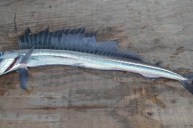Lurking out among that blue in the Gulf of Mexico is a hidden danger the size of New Jersey. It's called a dead zone, and no I'm not talking about that TV show starring Anthony Michael Hall.
A dead zone is an oxygen-depleted part of the ocean. It gets its moniker from the fact that it's harmful to life under the ocean. However, it appears that the spot is growing. Scientists have been aware of the dead zone for decades, but they were alarmed by how large the are has grown. It's located off the Gulf of Mexico near both Louisiana and Texas.
According to researchers, it's about the size of New Jersey. That's roughly 6,705 miles making for quite a large area. According to he National Oceanic and Atmospheric Administration (NOAA), it ranks among the top third of dead zones. It's grown from 4,298 square miles. But what exactly is the spot? Well, it's an area of the ocean where the water doesn't have enough oxygen. As such, marine life aren't able to survive in this area. Nutrient runoff causes the phenomenon.
Dead Zone In Gulf
Human activity plays a role with fertilizer run-off making its way into the Gulf. "Nutrient pollution impacts water bodies across the country and in the Gulf of Mexico it has resulted in a dead zone, where low to no oxygen does not support fish and marine life," said Bruno Pigott, acting assistant administrator of the EPA's Office of Water.
For decades, the United States has tried to find ways to reduce fertilizer runoff from farms. Chemicals in fertilizer cause changes in the ocean's algae. When algae die off, it creates an imbalance in oxygen in the ocean. "It's critical that we measure this region's hypoxia as an indicator of ocean health, particularly under a changing climate and potential intensification of storms and increases in precipitation and runoff," said Nicole LeBoeuf, assistant administrator of NOAA's National Ocean Service.
Unfortunately, the Mississippi River Nutrient Task Force has set a goal of 1,930 square miles for the dead zone. However, the current estimates are about 3.5 times higher than that goal.




